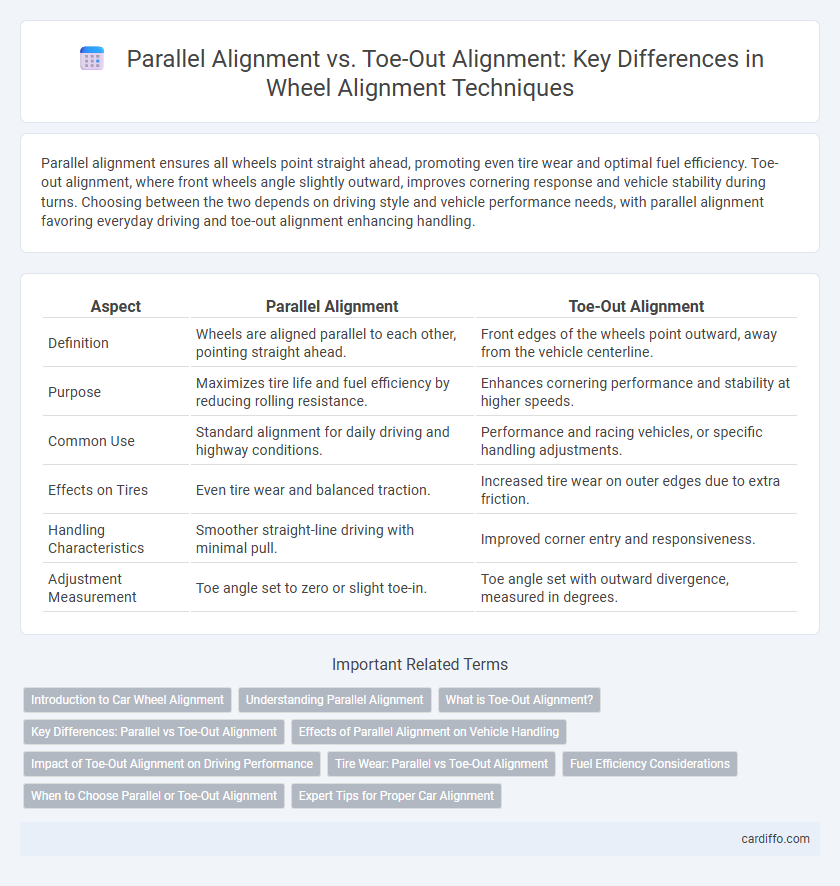Parallel alignment ensures all wheels point straight ahead, promoting even tire wear and optimal fuel efficiency. Toe-out alignment, where front wheels angle slightly outward, improves cornering response and vehicle stability during turns. Choosing between the two depends on driving style and vehicle performance needs, with parallel alignment favoring everyday driving and toe-out alignment enhancing handling.
Table of Comparison
| Aspect | Parallel Alignment | Toe-Out Alignment |
|---|---|---|
| Definition | Wheels are aligned parallel to each other, pointing straight ahead. | Front edges of the wheels point outward, away from the vehicle centerline. |
| Purpose | Maximizes tire life and fuel efficiency by reducing rolling resistance. | Enhances cornering performance and stability at higher speeds. |
| Common Use | Standard alignment for daily driving and highway conditions. | Performance and racing vehicles, or specific handling adjustments. |
| Effects on Tires | Even tire wear and balanced traction. | Increased tire wear on outer edges due to extra friction. |
| Handling Characteristics | Smoother straight-line driving with minimal pull. | Improved corner entry and responsiveness. |
| Adjustment Measurement | Toe angle set to zero or slight toe-in. | Toe angle set with outward divergence, measured in degrees. |
Introduction to Car Wheel Alignment
Car wheel alignment ensures optimal tire contact and vehicle handling by adjusting the angles of the wheels relative to each other and the road. Parallel alignment refers to setting both wheels on an axle perfectly parallel, promoting even tire wear and straight driving. Toe-out alignment involves angling the front of the wheels slightly away from each other, enhancing cornering performance and vehicle responsiveness.
Understanding Parallel Alignment
Parallel alignment ensures both front wheels are set exactly parallel to each other, minimizing uneven tire wear and improving vehicle stability. This alignment type optimizes traction and handling by maintaining equal angles on both wheels relative to the vehicle's centerline. Perfect parallel alignment reduces steering effort and maximizes fuel efficiency, making it essential for balanced tire performance.
What is Toe-Out Alignment?
Toe-Out alignment refers to the adjustment where the front edges of the tires point slightly away from each other, creating a divergence in the wheel direction. This setup enhances cornering stability and improves vehicle responsiveness during turns by increasing steering precision. In contrast to Parallel alignment, which keeps tires perfectly parallel, Toe-Out alignment intentionally introduces this outward angle to optimize handling performance.
Key Differences: Parallel vs Toe-Out Alignment
Parallel alignment maintains all wheels parallel to each other, ensuring even tire wear and optimal vehicle stability. Toe-out alignment angles the front wheels outward, enhancing cornering responsiveness and steering precision. Key differences lie in the intended handling effects and tire wear patterns, with parallel alignment prioritizing straight-line stability and toe-out alignment optimizing agility during turns.
Effects of Parallel Alignment on Vehicle Handling
Parallel alignment ensures that both front wheels point straight ahead, minimizing tire wear and improving fuel efficiency. Maintaining parallel alignment enhances vehicle stability during straight-line driving, resulting in smoother handling and better control. Proper parallel alignment reduces steering effort and prevents uneven tire traction, contributing to safer and more predictable vehicle performance.
Impact of Toe-Out Alignment on Driving Performance
Toe-Out alignment increases the angle at which the front wheels point outward, enhancing cornering response and steering precision by improving front-end grip. However, excessive toe-out can lead to uneven tire wear, decreased straight-line stability, and increased rolling resistance, negatively affecting fuel efficiency. Proper adjustment balances improved handling with tire longevity and vehicle stability during high-speed driving.
Tire Wear: Parallel vs Toe-Out Alignment
Parallel alignment ensures even tire wear by keeping all wheels parallel to each other, reducing uneven tread erosion and extending tire lifespan. Toe-out alignment causes the front of the tires to point outward, which can lead to increased wear on the inner or outer edges, accelerating tire degradation. Proper alignment settings tailored to driving style and vehicle specifications significantly impact tire performance and longevity.
Fuel Efficiency Considerations
Parallel alignment ensures all wheels are oriented straight, reducing rolling resistance and enhancing fuel efficiency by minimizing tire wear. Toe-out alignment, where front wheels angle outward, can increase tire drag and fuel consumption due to uneven tire contact. Optimizing alignment for parallel settings contributes to smoother driving dynamics and better mileage.
When to Choose Parallel or Toe-Out Alignment
Choose parallel alignment when tire wear is uneven across the tread or the steering feels unstable to ensure even handling and maximize tire life. Toe-out alignment is preferred for enhanced cornering performance, especially in sporty vehicles or when the front tires exhibit excessive toe-in, improving responsiveness at the expense of increased tire wear. Assess driving style, vehicle type, and specific alignment symptoms to determine the most effective adjustment between parallel and toe-out settings.
Expert Tips for Proper Car Alignment
Parallel alignment ensures that both front wheels are perfectly parallel, promoting even tire wear and optimal handling. Toe-out alignment involves angling the front wheels slightly outward, enhancing cornering response but requiring precise adjustment to avoid uneven tire degradation. Expert tips stress using advanced alignment tools, regularly checking suspension components, and consulting manufacturer specifications for accurate toe settings based on vehicle type and driving conditions.
Parallel Alignment vs Toe-Out Alignment Infographic

 cardiffo.com
cardiffo.com